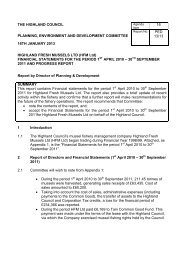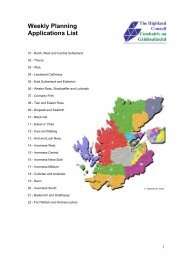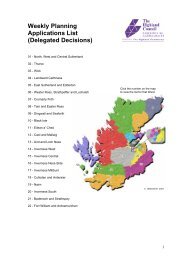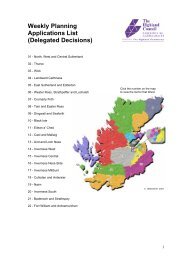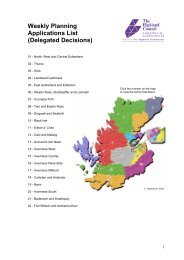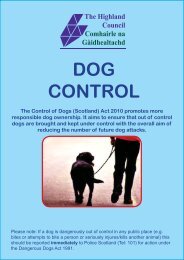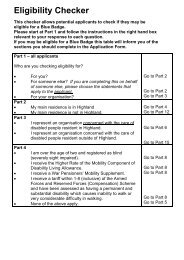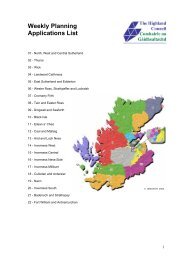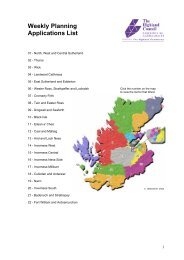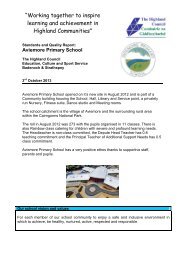Inverness City Centre Development Brief - The Highland Council
Inverness City Centre Development Brief - The Highland Council
Inverness City Centre Development Brief - The Highland Council
Create successful ePaper yourself
Turn your PDF publications into a flip-book with our unique Google optimized e-Paper software.
Supplementary Guidance<br />
Stiùireadh Leasachail<br />
<strong>Inverness</strong> <strong>City</strong> <strong>Centre</strong> <strong>Development</strong> <strong>Brief</strong><br />
Brath-leasachaidh Meadhan Cathair-bhaile<br />
Inbhir Nis<br />
MARCH 2013
<strong>Inverness</strong> <strong>City</strong> <strong>Centre</strong> <strong>Development</strong> <strong>Brief</strong><br />
Contents<br />
1. Introduction 2<br />
2. Context 3<br />
3. Five Key <strong>The</strong>mes 5<br />
4. Delivery 13<br />
1
<strong>Inverness</strong> <strong>City</strong> <strong>Centre</strong> <strong>Development</strong> <strong>Brief</strong><br />
Introduction<br />
<strong>Inverness</strong> is rightly considered as the ‘Capital of the <strong>Highland</strong>s’ due to its economic, social<br />
and environmental importance within both the North of Scotland and the country as a whole.<br />
Although the city centre has been the driving force in its development for centuries, as with<br />
most cities in the UK, over the last few decades various pressures have emerged which<br />
challenge the position of the city centre within the wider city region. Nevertheless, the centre<br />
of <strong>Inverness</strong> benefits from many valuable assets including its physical characteristics,<br />
transport links and rich history. One of the priorities for the <strong>Highland</strong> <strong>Council</strong> is to maintain<br />
and enhance the city centre’s potential as a desirable destination to live, work and visit.<br />
<strong>The</strong> purpose of this <strong>Development</strong> <strong>Brief</strong> is to deliver the aspirations set out in the <strong>Inverness</strong><br />
<strong>City</strong> Vision by identifying and promoting opportunities and actions for the redevelopment<br />
and enhancement of the city core. <strong>The</strong> actions seek to build upon the qualities and unique<br />
characteristics that <strong>Inverness</strong> offers and set out a clear vision to promote major growth. It<br />
also reflects the issues and comments raised from consultation with local communities,<br />
landowners, business, and key agencies.<br />
Achieving the proposals set out in the <strong>Development</strong> <strong>Brief</strong> will be dependent on working<br />
together with all stakeholders in the city centre. This includes those who live, work and visit<br />
the area, but equally important are the landowners and businesses. <strong>The</strong>refore, a major<br />
component of the <strong>Brief</strong> must be effective partnership working.<br />
2
<strong>Inverness</strong> <strong>City</strong> <strong>Centre</strong> <strong>Development</strong> <strong>Brief</strong><br />
Context<br />
Boundary<br />
<strong>The</strong> <strong>City</strong> <strong>Centre</strong> is defined in the map below. It extends from Friars Bridge to the north, the<br />
Infirmary Bridge to the south, Midmills to the east and Tomnahurich Street to the west. This<br />
should not be considered as a rigid boundary but include opportunities which may lie<br />
outwith the boundary. Parts of the surrounding areas such as towards Dalneigh, Longman<br />
and the High School offer the opportunity to become better connected and complementary<br />
parts of the <strong>City</strong> <strong>Centre</strong>.<br />
Policy<br />
<strong>Inverness</strong> <strong>City</strong> Vision<br />
<strong>The</strong> <strong>Inverness</strong> <strong>City</strong> Vision sets out a vision for<br />
shaping the future of the city. Overall it points to<br />
a number of key themes which will guide how<br />
<strong>Inverness</strong> will grow:<br />
• the economy should be at the heart of<br />
everything<br />
• strengthen the <strong>City</strong> <strong>Centre</strong><br />
• a better connected <strong>Inverness</strong><br />
• a city for young people<br />
• greenNess<br />
• build on our assets<br />
• think tourism<br />
• culture, pride and identity<br />
• health and well-being<br />
A key element of the <strong>City</strong> Vision is its emphasis on several areas of the city which are<br />
strategically important for the future prosperity of <strong>Inverness</strong>. <strong>The</strong> <strong>City</strong> <strong>Centre</strong> is one of these<br />
priority areas, and this brief is one of a series being developed which will guide future<br />
development in the city.<br />
In reference to the <strong>City</strong> <strong>Centre</strong>, the <strong>City</strong> Vision focuses on a number of important features.<br />
<strong>The</strong>se include expanding and defining the <strong>City</strong> <strong>Centre</strong>, taking full advantage of the waterfront<br />
area, enhancing green links and civic spaces, and developing effective linkages, priority<br />
streets and arteries throughout the city, referred to as the ‘spider’.<br />
<strong>Inverness</strong> <strong>City</strong> <strong>Centre</strong>: Future<br />
<strong>The</strong> wealth of assets that <strong>Inverness</strong> holds and the expected growth of the city in the coming<br />
years highlight the potential to re-establish the <strong>City</strong> <strong>Centre</strong> as the heart and soul of the city.<br />
<strong>The</strong> core vision of the <strong>City</strong> <strong>Centre</strong> <strong>Development</strong> <strong>Brief</strong> reflects and supports that of the<br />
3
<strong>Inverness</strong> <strong>City</strong> <strong>Centre</strong> <strong>Development</strong> <strong>Brief</strong><br />
<strong>Inverness</strong> <strong>City</strong> Vision. Overall the <strong>City</strong> Vision envisages that “what will emerge, very simply,<br />
is a resurgent <strong>City</strong> <strong>Centre</strong> as the heart of <strong>Inverness</strong>… which is a service centre for the<br />
whole <strong>Highland</strong> area.”<br />
Consequently the aspirations of this <strong>Brief</strong> are to:<br />
• Improve the commercial vitality and viability of the city <strong>Centre</strong>.<br />
• Make the <strong>City</strong> <strong>Centre</strong> the most attractive and desirable place for businesses to locate.<br />
• Enhance the user experience for tourists and other visitors.<br />
• Make the most of our historic buildings.<br />
• Reconnect the <strong>City</strong> <strong>Centre</strong> with the river frontage.<br />
• Increase connectivity and active travel to, from and within the <strong>City</strong> <strong>Centre</strong>.<br />
4
<strong>Inverness</strong> <strong>City</strong> <strong>Centre</strong> <strong>Development</strong> <strong>Brief</strong><br />
Five Key <strong>The</strong>mes<br />
To focus the proposals within the <strong>Development</strong> <strong>Brief</strong> five key themes are identified which<br />
highlight the challenges and opportunities within the <strong>City</strong> <strong>Centre</strong>:<br />
1. Built and Natural Environment – protecting and enhancing the rich and diverse<br />
cultural and natural heritage of the <strong>City</strong> <strong>Centre</strong> will promote place identify and<br />
maximise the visitor experience.<br />
2. Movement and Transport – the ability to move freely is essential to make the most of<br />
<strong>City</strong> <strong>Centre</strong> assets and allow all areas to prosper.<br />
3. Tourism – enhancing the tourist experience will encourage more people to visit<br />
<strong>Inverness</strong> and the <strong>Highland</strong>s of Scotland.<br />
4. Economy – supporting existing and attracting new businesses will strengthen the<br />
economy and re-establish a thriving environment.<br />
5. Living in the <strong>City</strong> <strong>Centre</strong> – Creating a strong and diverse city centre population has a<br />
range of social, economic and environmental benefits.<br />
<strong>The</strong>me 1: Built and Natural Heritage<br />
<strong>Inverness</strong> <strong>City</strong> <strong>Centre</strong> benefits from a rich diversity of cultural and natural heritage. This<br />
development brief will help to build on the success of recent projects which have helped to<br />
connect users of the <strong>City</strong> <strong>Centre</strong> with its heritage, such as Ness Islands Enhancement<br />
Programme and streetscape works and the work carried out by <strong>Inverness</strong> Old Town Art<br />
(IOTA).<br />
Natural Heritage<br />
One of the defining features of <strong>Inverness</strong> is the<br />
River Ness. Flowing right through the <strong>City</strong><br />
<strong>Centre</strong> the river has been intrinsically linked to<br />
the origins and development of <strong>Inverness</strong>.<br />
However, as with many other UK cities, the river<br />
frontage remains an underutilised asset. <strong>The</strong><br />
riverside frontage now presents an attractive and<br />
iconic tourist location and provides an appealing<br />
setting for leisure, office and residential uses.<br />
<strong>The</strong>re are many important views and vistas in<br />
the <strong>City</strong> <strong>Centre</strong>. Some of these include from Bridge Street along to Tomnahurich Street and<br />
Ness Walk, Castle Wynd down Church Street, and both up the river to the Islands and the<br />
Castle and down to the Greig Street Bridge with Ben Wyvis in the backdrop. <strong>The</strong>se views<br />
define the city centre’s relationship with its built and natural heritage. As a result these vistas<br />
will be protected and where possible enhanced to maximise these important assets.<br />
5
<strong>Inverness</strong> <strong>City</strong> <strong>Centre</strong> <strong>Development</strong> <strong>Brief</strong><br />
Built Heritage<br />
One of the <strong>City</strong> <strong>Centre</strong>’s key qualities is its diverse stock of historical buildings and<br />
monuments. <strong>The</strong> <strong>City</strong> <strong>Centre</strong> alone boasts 11<br />
Grade A and just over 120 Grade B or C listed<br />
buildings. As a result, almost the entire area is<br />
included within two Conservation Areas: the<br />
Riverside Conservation Area and the Crown<br />
Conservation Area. <strong>The</strong> designation of a<br />
conservation area is a means to safeguard and<br />
enhance the sense of place, character and<br />
appearance of our most valued historic places.<br />
Providing an attractive and comfortable public<br />
realm is an essential feature in supporting local<br />
businesses and encouraging visitors and local residents to spend time in the area. <strong>The</strong> recent<br />
series of streetscape improvements have successfully created a more pedestrian friendly<br />
environment. However there remain areas of the <strong>City</strong> <strong>Centre</strong> that would greatly benefit from<br />
further improvements. <strong>The</strong> creation of more parks and civic spaces for residents, workers<br />
and visitors to enjoy should also be a key consideration in any redevelopment proposal.<br />
6<br />
<strong>The</strong>me 2:
<strong>Inverness</strong> <strong>City</strong> <strong>Centre</strong> <strong>Development</strong> <strong>Brief</strong><br />
Movement / Transport<br />
Movement and access have a critical role in making <strong>Inverness</strong> a sustainable and functional<br />
place. As the Capital of the <strong>Highland</strong>s, <strong>Inverness</strong> is a transport hub and stopping off point for<br />
many visitors.<br />
<strong>The</strong> <strong>City</strong> <strong>Centre</strong> benefits from having a number of pedestrianised streets together with the<br />
main rail and bus stations in very central and convenient locations. Despite this, more can be<br />
done to create an integrated and effective transport system which will improve the flow of<br />
movement to, from and within the <strong>City</strong> <strong>Centre</strong>.<br />
Road Transport<br />
<strong>The</strong> road network provides a very limited number of connections across the city resulting in<br />
significant congestion at peak times in certain locations. This limits the opportunities for<br />
changes to traffic management and in increasing priority for pedestrians, cyclists and public<br />
transport. However the construction of the West Link with a new river crossing upstream will<br />
result in a significant reduction in traffic in the <strong>City</strong> <strong>Centre</strong> and open up opportunities for<br />
improving the environment for active travel and public transport.<br />
<strong>The</strong> provision of well-located and convenient car parking is an important requirement of<br />
boosting the vitality of the <strong>City</strong> <strong>Centre</strong> economy. An opportunity may exist for the<br />
development of a car park on the west side of the river which would serve the flow of people<br />
entering the city centre from the West and South.<br />
Creating park and ride facilities is a priority for the <strong>Council</strong>. This would allow people to<br />
travel to <strong>Inverness</strong> by car, park for free in secure car parks and complete the journey into the<br />
city centre by bus. <strong>The</strong> first park and ride is likely to be on the East of the city and situated<br />
adjacent to the A96. Other potential sites for park and ride include at Torvean as part of the<br />
West Link and adjacent to the A9 to the North of the city.<br />
Taxis provide an important transport service in the city centre for both residents and visitors.<br />
Due to steady increases in the number of licenced drivers additional ranks have been created<br />
with a capacity of 30 daytime and 50 night time spaces. Developing an efficient taxi network<br />
requires ranks to be located in convenient places but which do not impact on traffic flow or<br />
safety issues.<br />
Public Transport<br />
Creating an efficient public transport service is an<br />
important factor in improving the <strong>City</strong> <strong>Centre</strong>.<br />
<strong>The</strong> options are currently limited by the restricted<br />
road network and it is anticipated that a general<br />
reduction in <strong>City</strong> <strong>Centre</strong> traffic resulting in the<br />
construction of the West Link will aid the<br />
development of public transport. A Transport<br />
Infrastructure for Growth (TIG) traffic model is<br />
7
<strong>Inverness</strong> <strong>City</strong> <strong>Centre</strong> <strong>Development</strong> <strong>Brief</strong><br />
being developed by the <strong>Council</strong> to identify implications on the wider road network from<br />
potential developments across the <strong>Inverness</strong> travel to work area. This will highlight roads<br />
which require particular attention and identify opportunities for improved public transport.<br />
Active Travel<br />
<strong>Inverness</strong> benefits from higher levels of active travel (cycling and walking) than both the<br />
<strong>Highland</strong> and national averages. As a result <strong>Inverness</strong> is well on its way to meeting the<br />
Scottish Government’s 2020 target of 10% of all journeys made by bike. To build on this, an<br />
Active Travel Audit for <strong>Inverness</strong> was carried out by Halcrow Group in 2011. This detailed<br />
analysis highlighted several improvements which<br />
could be made to further encourage active travel.<br />
One of the key opportunities is to address the<br />
disproportionate level of cycling infrastructure.<br />
Some areas of the <strong>City</strong> <strong>Centre</strong>, including key<br />
entry routes, remain dominated by vehicular<br />
traffic. Shown in the map below, the Active<br />
Travel Audit recommends 8 main designated<br />
cycle routes for <strong>Inverness</strong>, each of which form<br />
clear and safe travel corridors to and from the<br />
<strong>City</strong> <strong>Centre</strong>.<br />
A number of opportunities and improvements have been put forward for each of the routes.<br />
A key proposal includes the introduction of two-way cycling lanes throughout the existing<br />
streetscaped areas and extending this to the river frontage and suspension bridges. Another<br />
opportunity exists to create an active travel hub within the <strong>City</strong> <strong>Centre</strong> which could include<br />
cycle parking, seating, cycle hire facilities and information services. This could correspond<br />
with the Great Glen Way and National Cycle Routes 1, 7 and 78 which join around the west<br />
end of High Street on the banks of the River Ness.<br />
8
<strong>Inverness</strong> <strong>City</strong> <strong>Centre</strong> <strong>Development</strong> <strong>Brief</strong><br />
Permeability refers to the directness of links and the density of connections. As connectivity<br />
increases, travel distances decrease and route options increase, allowing more direct travel<br />
between destinations, creating a more accessible and resilient <strong>City</strong> <strong>Centre</strong>. Maximising<br />
accessibility and the flow of movement to, from and within areas of the <strong>City</strong> <strong>Centre</strong> is crucial.<br />
<strong>The</strong> recent developments at Strothers Lane are a good example of improving permeability by<br />
incorporating a traditional close into the design to allow for more direct access into other<br />
areas.<br />
<strong>The</strong>me 3: Tourism<br />
Tourism is becoming an ever more important aspect of the<br />
Scottish economy and no-more so than in <strong>Highland</strong>. <strong>Inverness</strong><br />
is a key tourist destination in its own right and was found to be<br />
the 2 nd most popular tourist city in Scotland (behind<br />
Edinburgh) and the 8 th most popular location in the UK.<br />
Tourist Attractions & Facilities<br />
<strong>The</strong>re is ongoing work to improve and promote the assets<br />
which the <strong>City</strong> <strong>Centre</strong> has to offer such as those highlighted in<br />
the Historic Tourist Trail leaflet below. However, it is clear that<br />
there is still scope to greatly improve the visitor experience.<br />
Creating a clear and natural tourist trail round the <strong>City</strong> <strong>Centre</strong><br />
is a key priority.<br />
9
<strong>Inverness</strong> <strong>City</strong> <strong>Centre</strong> <strong>Development</strong> <strong>Brief</strong><br />
Coach Facilities<br />
<strong>The</strong> coach industry is a vital part of the tourism<br />
and transport sectors. It is estimated that 70,000<br />
visitors dock on cruise ships in the <strong>Inverness</strong> area<br />
each year. Yet only a fraction of these people<br />
actually visit <strong>Inverness</strong> and those that do are<br />
reported to spend on average only 45 minutes<br />
there. <strong>The</strong>refore, the ability to provide dedicated<br />
coach facilities within the core of <strong>Inverness</strong> would<br />
have significant tourism and economic benefits.<br />
This could also have added benefits for other<br />
development proposals in the brief such as the<br />
promotion of the Victorian Market as an indoor<br />
tourist facility. <strong>The</strong> coach facilities do not need to<br />
be associated with the bus or rail station but must<br />
be in accessible location for the <strong>City</strong> <strong>Centre</strong>. An<br />
alternative may be to create designated coach<br />
drop-offs in the centre of the city with allocated<br />
parking situated in the periphery.<br />
<strong>The</strong>me 4: Economy<br />
<strong>The</strong> <strong>City</strong> <strong>Centre</strong> has traditionally been the market<br />
place and centre point of commercial activity of<br />
<strong>Inverness</strong>. A key aim of this brief is to continue<br />
this by strengthen existing businesses and<br />
supporting new businesses to develop.<br />
Retail<br />
<strong>Inverness</strong> <strong>City</strong> <strong>Centre</strong> is the retail hub of the<br />
<strong>Highland</strong>s and Islands. Historically the prime<br />
retail area comprised of virtually all of the Old<br />
Town. More recently this area has contracted and<br />
arguably comprises of the Eastgate shopping<br />
centre and the top end of the High Street. <strong>The</strong><br />
retail units in the Old Town have been<br />
experiencing steady decline in footfall and due to<br />
the current economic downturn has resulted in<br />
many properties struggling to attract occupiers. A<br />
key priority for the <strong>Council</strong> it to help draw people<br />
through the centre and encourage people to visit<br />
other areas than simply the prime retail areas.<br />
Office Space<br />
10
<strong>Inverness</strong> <strong>City</strong> <strong>Centre</strong> <strong>Development</strong> <strong>Brief</strong><br />
As with retail, <strong>City</strong> <strong>Centre</strong> has traditionally been the prime business area within <strong>Inverness</strong> and<br />
the <strong>Highland</strong> region. However, over the past 10-15 years the trend has been for major office<br />
occupiers (both private and public sector) to locate to peripheral regions of the city. This has<br />
largely been driven by the requirement for modern open-plan accommodation with large<br />
floor plates and parking provision. Overall, it has resulted in the business landscape<br />
becoming fragmented and dispersed with greater reliance on vehicular transport.<br />
<strong>The</strong> creation of a dedicated business district will help to encourage business back to the <strong>City</strong><br />
<strong>Centre</strong> by promoting and supporting a <strong>City</strong> <strong>Centre</strong> business environment. It will also<br />
highlight to companies the range of benefits of being situated within the <strong>City</strong> <strong>Centre</strong><br />
including access to public transport, proximity to other businesses, higher levels of<br />
sustainability etc. Emphasis will be placed on consolidating the existing office stock within<br />
the <strong>City</strong> <strong>Centre</strong> together with the development of modern, sustainable office space.<br />
Opportunities may exist to allow the development of higher buildings in and around Farraline<br />
Park and Rose Street. This may make development opportunities more financially viable and<br />
allow for the provision of larger, more flexible floorplates which are becoming increasing<br />
more in demand. This would only be supported by the <strong>Council</strong> dependent on the highest<br />
quality of design and siting which complements the surrounding townscape. <strong>The</strong> recent<br />
development at Strothers Lane is a good example of how this can be achieved.<br />
Other options include the redevelopment of older buildings which are no longer fit for<br />
purpose while retaining existing facades.<br />
<strong>The</strong>me 5: Living in the <strong>City</strong><br />
Existing & Future Residents<br />
<strong>The</strong> centre of <strong>Inverness</strong> has always been an area<br />
with a significant population. Towards the end of<br />
the 20 th century, however, the trend was for<br />
housing to be located outwith the <strong>City</strong> <strong>Centre</strong>. A<br />
key aim is now on attracting people back to the<br />
<strong>City</strong> <strong>Centre</strong> to re-establish a diverse and strong<br />
inner-city community. Over the past decade<br />
housing development has helped to regenerate<br />
many areas of <strong>Inverness</strong> <strong>City</strong> <strong>Centre</strong> and the<br />
<strong>Council</strong> would encourage further housing<br />
development, particularly within vacant upper<br />
floors of historic buildings.<br />
Affordable Housing<br />
11
<strong>Inverness</strong> <strong>City</strong> <strong>Centre</strong> <strong>Development</strong> <strong>Brief</strong><br />
Due to its wide ranging social and economic implications an adequate supply of affordable<br />
housing is a key priority for <strong>The</strong> <strong>Highland</strong> <strong>Council</strong>. An innovative approach to promoting and<br />
supporting affordable housing development could assist, not just in helping to meet housing<br />
needs, but also contribute significantly to the regeneration of the <strong>City</strong> <strong>Centre</strong>. In addition,<br />
this in turn would increase the population of the city centre and help to make sustainable<br />
communities and support the local economy.<br />
Student Accommodation<br />
With the development of the University of the <strong>Highland</strong>s and Islands Campus over the<br />
coming years, it is anticipated that dedicated student accommodation will be required both<br />
on and off campus. <strong>The</strong> <strong>City</strong> <strong>Centre</strong> provides an ideal setting for the creation of a student<br />
hub as this type of development has played a key role in urban renewal in other city centres,<br />
such as in Dundee, Liverpool and Leeds.<br />
In recent years, student accommodation has also become a property sector in its own right<br />
and has shown resilience during the economic downturn. Consequently, it is an area which<br />
may present an attractive prospect for developers. Forming a student hub in the city centre<br />
may in turn kick-start adjoining development opportunities and be steered to assist in the<br />
delivery other objectives of this brief.<br />
12
<strong>Inverness</strong> <strong>City</strong> <strong>Centre</strong> <strong>Development</strong> <strong>Brief</strong><br />
Delivery<br />
Translating these development opportunities, many of which may face significant challenges,<br />
into achievable plans is crucial for the future of <strong>Inverness</strong> <strong>City</strong> <strong>Centre</strong>.<br />
As a result, the policy tools and potential funding solutions which may be available to help<br />
drive development forward are outlined below. Based on the 5 <strong>The</strong>mes above, this is<br />
followed by actions associated with particular areas of the city centre. This is followed by a<br />
detailed Action Plan which will help reach the aspirations in this brief.<br />
Policy Tools<br />
<strong>The</strong>re is a requirement to implement creative changes to attract and support new<br />
development opportunities. <strong>The</strong> <strong>Council</strong> will assist both passively and directly, to support<br />
and promote the take up of the development opportunities which are outlined in this<br />
document.<br />
<strong>The</strong>re will also be a proactive approach in key areas of activity including:<br />
• Facilitating discussions and negotiations between landowners<br />
• Helping to facilitate land assembly<br />
• Identifying potential development partners<br />
• Seeking grant and other funding for advance infrastructure and other works<br />
• Using a variety of statutory powers where there are agreed needs and public benefits<br />
• Provision of access to transport models, flood information, etc.<br />
• Promoting proposals to external audiences, including government departments and<br />
the investment community.<br />
<strong>The</strong> <strong>Council</strong> will also continue to work closely together with key partners, such as <strong>Inverness</strong><br />
BID who can help to deliver the objectives outlined in this brief.<br />
<strong>The</strong>se proposals also emphasise the need for intending developers to approach and involve<br />
relevant sections of the <strong>Council</strong> at a very early stage.<br />
Potential Funding Solutions<br />
Understanding the potential funding solutions for the delivery of these proposals is central to<br />
establishing an invigorated <strong>City</strong> <strong>Centre</strong>. <strong>The</strong> investment plans will take place through<br />
financial and other support provided by a number of stakeholders including the private sector<br />
and other funding sources. Some of these include:<br />
• <strong>Inverness</strong> Common Good Fund – has the potential to play a significant role in helping<br />
to stimulate specific developments which will contribute to public benefit.<br />
• Conservation Area Regeneration Scheme (CARS) – to help maintain and restore the<br />
character of conservation areas including attracting more visitors and boosting the<br />
economy.<br />
• Townscape Heritage Initiative (THI) – aims to help communities to regenerate<br />
13
<strong>Inverness</strong> <strong>City</strong> <strong>Centre</strong> <strong>Development</strong> <strong>Brief</strong><br />
conservation areas, encourage partnerships and improve the quality of life for all those<br />
who live, work or vist an area. A THI bid is currently being considered which could<br />
include either the whole city centre or particular parts such as the north of Church<br />
Street/ Academy Street.<br />
• Tax Increment Financing (TIF) – although in the early stages of development, TIFs are<br />
designed to allow local authorities to borrow to fund infrastructure and/or other<br />
capital projects against predicted growth in local business rates.<br />
• Business Premises Renovation Allowance (BPRA) – Allowances which are aimed at<br />
bringing back into use derelict or vacant buildings.<br />
• Cities Investment Fund – <strong>The</strong> recent announcement of the £5m Cities Investment Fund<br />
by the Scottish Government will support the Scottish Cities Alliance and will allow<br />
Scottish cities, including <strong>Inverness</strong>, to work together to offer large economies of scale<br />
to potential investors. <strong>The</strong> focus is particularly on aspects of digital and physical<br />
connectivity, tourism and higher education<br />
<strong>The</strong> <strong>Council</strong> will also seek additional support whenever possible. For example, the <strong>Highland</strong><br />
<strong>Council</strong> successfully applied to be part of the European Union’s QUEST programme which<br />
provides assistance in the creation of transportation strategies for small cities. This will help<br />
significantly in creating a robust transport plan for <strong>Inverness</strong> by building on the existing<br />
Active Travel Audit and the Transport Infrastructure for Growth (TIG) model.<br />
Five Key Districts<br />
Taking account of the issues covered under the Five <strong>The</strong>mes, the <strong>City</strong> <strong>Centre</strong> can be defined<br />
within the following key districts:<br />
1. Old Town<br />
2. East of Academy Street<br />
3. River<br />
4. Retail Core<br />
5. Castle<br />
Each district has its own unique characteristics and the specific opportunities that they offer<br />
are outlined below.<br />
14
<strong>Inverness</strong> <strong>City</strong> <strong>Centre</strong> <strong>Development</strong> <strong>Brief</strong><br />
1. Old Town<br />
As the name suggests the Old Town, which incorporates the area between the river and<br />
Academy Street and from Friars Street to High Street, is the oldest part of <strong>Inverness</strong>.<br />
Although it holds some of the <strong>City</strong>’s richest heritage and is a key visitor attraction, a lack of<br />
investment and declining footfall has resulted in a loss of vitality and vibrancy. This in turn<br />
has resulted in a number of regeneration opportunities.<br />
Adaptation of Historic Buildings<br />
Much of the Old Town’s wealth of built heritage is largely underutilised. This is particularly<br />
the case with the upper floors of historic buildings.<br />
A key opportunity to re-energise the <strong>City</strong> <strong>Centre</strong>, therefore, is the sensitive re-use of historic<br />
properties. <strong>The</strong> adaptation and re-use of historic buildings, including upper floors should be<br />
considered as part of any regeneration proposal.<br />
<strong>The</strong> townscape of the Old Town and other areas covered by the two conservation areas will<br />
be safeguarded and enhanced by resisting development proposals that would adversely<br />
affect the character or historic interest. As a result there is a presumption against demolition<br />
15
<strong>Inverness</strong> <strong>City</strong> <strong>Centre</strong> <strong>Development</strong> <strong>Brief</strong><br />
or other development that may adversely affect a listed building or its setting. It should be<br />
noted that proposals for the demolition of a listed or historic buildings within a conservation<br />
area will be assessed against the Scottish Historic Environment Policy (SHEP).<br />
Permeability<br />
Maximising accessibility and the flow of movement to, from and within areas of the <strong>City</strong><br />
<strong>Centre</strong> is crucial. One of the key proposals is to develop a strategy to improve the<br />
permeability of the Old Town area, specifically around the north of Academy Street and<br />
Church Street. Opportunities exist to enhance the connectivity to the main streets, the city’s<br />
key assets and from arrival points. Specifically, traffic rationalisation on Academy Street<br />
would assist with improving links between the bus and rail stations, and Rose Street Car Park<br />
with the Old Town.<br />
<strong>The</strong> West Link will significantly reduce congestion within the <strong>City</strong> <strong>Centre</strong>. However, significant<br />
amendments to the road network will be limited until this is completed.<br />
Improving connections to the river front presents another key opportunity. <strong>The</strong> Old Town<br />
lacks clear vistas to naturally steer people to the river frontage and the main linking streets<br />
(Bank Lane and Fraser Street) are currently not inviting for pedestrians. Consequently short<br />
term proposals could include wayfinding and interpretation improvements such as<br />
introducing clear and simple signage to direct pedestrian flow to the riverside. In addition,<br />
opportunities exist to remove unnecessary traffic and parking on Bank Lane and Fraser Street.<br />
Redirecting bus routes from Union Street may also allow for the removal of the right hand<br />
filter and in turn could lead to the creation of a pedestrian crossing opposite the Victorian<br />
Market. Longer term proposals may include the redevelopment of the buildings surrounding<br />
Bank Lane and providing pedestrians with priority on Fraser Street.<br />
Victorian Market Action Area<br />
<strong>The</strong> Victorian Market is one of the <strong>City</strong> <strong>Centre</strong>’s most unique and valuable assets but it has<br />
potential to attract a wider range of visitors. <strong>The</strong> Victorian Market also presents the most<br />
feasible location to promote as a dedicated tourist facility in the short term. As a result the<br />
<strong>Council</strong> has identified the following development opportunities which could help create a<br />
more vibrant Victorian Market place:<br />
• Enhancing the legibility of the entry points to the market would help to create a more<br />
welcoming environment and attract passers-by. Further streetscape works at the main<br />
entrance and at Falcon Square, including clearly defined pedestrian crossings, would<br />
also help to direct people into the market.<br />
16
<strong>Inverness</strong> <strong>City</strong> <strong>Centre</strong> <strong>Development</strong> <strong>Brief</strong><br />
• Another opportunity is to encourage a wider mix of tenants within the Victorian<br />
Market. At present the market is only open during standard working hours. However,<br />
it is proposed that night time uses such as restaurants, cafes, and live entertainment<br />
could make it a distinctive all-day, all-weather facility. This would help to contribute to<br />
a buoyant and diverse evening <strong>City</strong> <strong>Centre</strong> economy.<br />
• <strong>The</strong> market currently consists of relatively narrow walkways with a small number of<br />
benches located near the main entrance. Accordingly, the reworking of the ground<br />
floor premises and the addition of a mezzanine floor in the Market Hall should be<br />
explored. This could help to open the market up, create a civic space in the centre<br />
while also increasing the rate of return.<br />
• Similar traditional indoor markets include Merchant Square and Princess Square in<br />
Glasgow. <strong>The</strong>se have clear and welcoming entrances and a mix of uses including retail<br />
units, cafes, restaurants, bars, stalls, and arts and crafts fairs. Together, this<br />
combination of uses provides both daytime and night-time attractions.<br />
17
<strong>Inverness</strong> <strong>City</strong> <strong>Centre</strong> <strong>Development</strong> <strong>Brief</strong><br />
2. East of Academy Street<br />
This area extends from the Iron Works at Chapel<br />
Street to Falcon Square and east from Academy<br />
Street to Railway Terrace. Incorporating some of<br />
the <strong>City</strong>’s most important buildings and with<br />
excellent transport linkages the area East of<br />
Academy Street offers many major regeneration<br />
opportunities.<br />
Dedicated Business District / Student Hub<br />
<strong>The</strong> area provides an ideal setting for both the establishment of a dedicated business district<br />
and the creation of a student hub including accommodation and union. This would help to<br />
create a vibrant and lively daytime and night-time environment by encouraging a range of<br />
new users including young people and office workers. It would also exploit the valuable<br />
characteristics of the area including its central location, transport links, height of existing<br />
buildings and view over the city.<br />
Due to its physical characteristics and surrounding land uses the Academy Street action area<br />
is one of the only areas with potential for multi-storey development. As a result there may be<br />
an opportunity to (re)develop more elevated buildings in the area. This would help to add to<br />
the value of development by offering excellent views of the river and over the city from the<br />
upper floors and the feasibility of uses, such as retail, office, tourism, housing and parking.<br />
Any new development in this area, however, must be of the highest quality and demonstrate<br />
clearly how they sit within and complement the surrounding area including the neighbouring<br />
Conservation Areas.<br />
Transport<br />
This district also includes both the main bus and rail stations and for thousands of people<br />
these are their first experience of <strong>Inverness</strong> and the <strong>Highland</strong>s. <strong>The</strong>refore the <strong>Council</strong> will<br />
encourage the improvements to the area surrounding the stations and to the frontages<br />
themselves.<br />
Streetscape<br />
Following a phase of review of the existing streetscape works, there may be scope to extend<br />
the scheme into a third phase, should funding become available. As the main through route<br />
and a key retail location there is significant potential to improve Academy Street. By<br />
widening footpaths, creating clearly-defined pedestrian crossings and removing clutter it<br />
would make Academy Street safer, give active travel users confidence and shift the<br />
dominance from the car towards pedestrians. Soft landscaping may also enhance the<br />
entrance of Academy Street and create a welcoming atmosphere.<br />
18
<strong>Inverness</strong> <strong>City</strong> <strong>Centre</strong> <strong>Development</strong> <strong>Brief</strong><br />
Academy Street<br />
Academy Street is one of the oldest streets in <strong>Inverness</strong> and continues to be a main<br />
thoroughfare through the <strong>City</strong>. However, it is a street under both physical and economic<br />
stress. <strong>Inverness</strong> Heritage Trust commissioned Neil Sutherland Architects LLP to carry out a<br />
detailed investigation into the scope, scale and practicality of carrying out improvement<br />
activities on the street. Following analysis of its historical context and current function the<br />
project highlighted particular opportunities for the street and the spaces which adjoin it. This<br />
includes creating an improved entrance at the junction with Chapel Street and improvements<br />
to the key civic spaces (see below the analysis map and indicative designs for Farraline Park,<br />
Station Square and Falcon Square).<br />
19
<strong>Inverness</strong> <strong>City</strong> <strong>Centre</strong> <strong>Development</strong> <strong>Brief</strong><br />
Farraline Park Action Area<br />
<strong>The</strong> Farraline Park and Rose Street area offers some of the best redevelopment opportunities<br />
in the <strong>City</strong> <strong>Centre</strong>, including:<br />
• A key proposal is to provide greater connections from the A82 and existing college site<br />
into the <strong>City</strong> <strong>Centre</strong> and through to the river frontage. A short term opportunity may<br />
be for the widening of pavements and pedestrian crossings on Academy Street and<br />
Margaret Street. This would create a safer environment and help encourage the flow<br />
of people through the Old Town while having little impact on traffic capacity.<br />
• Opportunity also exists for the relocation of the taxi rank from Margaret Street as this<br />
would reduce user conflict and allow for pedestrian priority. Relocating the taxi rank<br />
to Strothers Lane could utilise the existing wide pavements.<br />
• 92-94 Academy Street offers a strategically important site for the Academy Street<br />
action area. Redevelopment of the site should include a pedestrian link Rose<br />
Street/Farraline Park area helping the wider development and accessibility in this area.<br />
• A key longer term aim is to bring forward renovation opportunities for the Grade A<br />
listed library building such an improved library/community facility or indoor tourist<br />
facility.<br />
• <strong>The</strong> formation of dedicated civic spaces presents an important opportunity for the<br />
Academy Street area. In the short term, any change of bus layout could allow for the<br />
extension of civic space at the front of the library. This would make greater use of the<br />
20
<strong>Inverness</strong> <strong>City</strong> <strong>Centre</strong> <strong>Development</strong> <strong>Brief</strong><br />
library building and provide an enclosed and sheltered space at the new business<br />
district.<br />
• It is envisages that in the longer term the bus station should be relocated and the<br />
whole of Farraline Park become the main civic hub for the <strong>City</strong>. <strong>The</strong> <strong>Council</strong> will<br />
continue to work with stakeholders to ensure that the framework is in place for this to<br />
develop.<br />
<strong>The</strong> map below shows a long term vision of the area East of Academy Street. It includes<br />
significant redevelopment of particular areas with integrated bus and rail stations together<br />
with creation of a major civic space and excellent connections.<br />
21
<strong>Inverness</strong> <strong>City</strong> <strong>Centre</strong> <strong>Development</strong> <strong>Brief</strong><br />
3. River<br />
This <strong>City</strong> <strong>Centre</strong> district extends from Friars Bridge and extends to Infirmary Bridge<br />
incorporating areas such as the former swimming pool site at Glebe Street and down to Eden<br />
court and the Cathedral. Any development adjoining or within the River Ness must give<br />
careful consideration of any potential impact on the River Moriston Special Area of<br />
Conservation.<br />
Opening up River Ness Frontage<br />
<strong>The</strong> river frontage is an attractive place for visitors, residents and businesses and many<br />
opportunities exist for redevelopment. <strong>The</strong> <strong>Council</strong> will support development along the river<br />
frontage and within the <strong>City</strong> <strong>Centre</strong> as a whole which helps to open up and reconnect the<br />
river with the <strong>City</strong> <strong>Centre</strong>. This is particularly the case for development which contributes to<br />
improving public value and increasing accessibility from areas such as the Old Town, the rail<br />
and bus stations and the main car parks. <strong>The</strong>se would also help to make valuable green<br />
spaces, such as the Ness Islands, Bellfield Park and the Bught more accessible.<br />
<strong>The</strong> river frontage is also an attractive location for cyclists and includes sections of the<br />
National Cycle Network. However, it is clear that much more can be done to encourage and<br />
give priority to active travel along the river. <strong>The</strong> plans for the River Ness flood alleviation<br />
scheme (FAS) should be used to enhance the current National Cycle Routes and be<br />
developed in correspondence with future cycling routes as outlined in the Active Travel Audit.<br />
<strong>The</strong>re is also the opportunity to establish a clear path network to the harbour area which has<br />
various tourist attractions such as boat trips and view points. This would also help support<br />
the <strong>Inverness</strong> Harbour Trust plans to expand and attract cruise liners to the <strong>City</strong>.<br />
Glebe Street Action Area<br />
• <strong>The</strong> area around Glebe Street is a prime river front location and forms a key gateway<br />
to the <strong>City</strong> <strong>Centre</strong>. As a result it offers ideal redevelopment opportunities:<br />
• Plans for a 166 bedroom, 4 star hotel and associated car parking at Glebe Street was<br />
approved in 2010. If completed, this will see the major redevelopment of a key <strong>City</strong><br />
<strong>Centre</strong> site which has remained vacant for many years. Alternative uses which the<br />
<strong>Council</strong> may support include residential, business or tourism.<br />
• <strong>The</strong> hotel proposals will free up a piece of land next to the current paved pedestrian<br />
area at the roundabout. Together with the wide pavement on the other side of Chapel<br />
Street, the area forms a major gateway into the <strong>City</strong> <strong>Centre</strong>. As a result it has<br />
significant opportunity to be the location of an iconic piece of public art that welcomes<br />
people from the North and West to the centre of <strong>Inverness</strong>. Alternatively, tree planting<br />
would help to improve a key entrance to the city. <strong>The</strong> provision of seating (possibility<br />
similar to the successful Ness Islands seating) and tree/shrub planting could also help<br />
to create a welcoming gateway. Additionally, developer contributions may be used to<br />
provide improved pedestrian links and crossings.<br />
22
<strong>Inverness</strong> <strong>City</strong> <strong>Centre</strong> <strong>Development</strong> <strong>Brief</strong><br />
• It is proposed that the <strong>Council</strong>-owned land between the boundaries of the hotel and<br />
the FAS could be enhanced by tree planting and the provision of seating. It is<br />
understood that the hotel applicant may be willing to deliver this opportunity. <strong>The</strong><br />
area under Friars’ Bridge may also benefit from streetscape improvements and public<br />
art such as a mural or lighting.<br />
• Linkages should also be made between the Glebe Street development opportunities<br />
and the former telephone exchange building (Fraser House) which also offers a prime<br />
development site should it become available.<br />
•<br />
4. <strong>The</strong> Castle<br />
This district, which includes that between Bridge Street, Castle Street and the river, is arguably<br />
the most prominent in the <strong>City</strong> <strong>Centre</strong>. It benefits from being in a central location, a natural<br />
destination for visitors due to its excellent vistas and boasts high levels of footfall.<br />
Consequently there are several major redevelopment opportunities.<br />
• Key redevelopment/renovation opportunities exist for the former Crofters Commission<br />
building at 4 Castle Wynd. <strong>The</strong> whole upper floors of Bridge Street could have the<br />
potential to be redeveloped if the tourist information service was relocated. Possible<br />
uses may include residential, retail, office, civic or leisure space.<br />
• Consequently a key opportunity exists to redevelop the public toilet block. By<br />
23
<strong>Inverness</strong> <strong>City</strong> <strong>Centre</strong> <strong>Development</strong> <strong>Brief</strong><br />
extending the existing building the site could provide an appropriate space for<br />
relocating the tourist information service and/or for other retail uses such as a cafe.<br />
With continued efforts for rationalising <strong>Highland</strong> <strong>Council</strong> offices, an opportunity may<br />
also exist for the Town House to be used for more civic and ceremonial uses than at<br />
present. This would also help to reduce commuter demand for the Castle Street car<br />
park. In the long run, this may allow for complete redevelopment of the car park to<br />
reflect its prime location within the <strong>City</strong> <strong>Centre</strong>.<br />
• <strong>The</strong> streetscape improvements, which have been successful in creating attractive and<br />
permeable environments, could be extended to the Bridge Street area as this forms a<br />
gateway to the Old Town and retail core and holds many of the most precious vistas.<br />
• Opportunity exists to enhance the prominent vistas which this part of the city benefits<br />
from. For example, the elevated position at the public toilet block holds an impressive<br />
view of Church Street.<br />
• An active travel hub/terminus could be established in correspondence with any<br />
development at the disused toilet block. This would help to establish a definable<br />
starting/finishing/stopping-off point for increasing popular recreational pursuits such<br />
as the Great Glen Way and the National Cycle Routes.<br />
• This area could also be improved through the removal of the rear service access, bins<br />
and parking spaces for the tourist information building. An opportunity may exist to<br />
establish a single shared service yard at the rear of the museum.<br />
24
<strong>Inverness</strong> <strong>City</strong> <strong>Centre</strong> <strong>Development</strong> <strong>Brief</strong><br />
5. Retail Core<br />
<strong>The</strong> Retail Core includes the High Street and the Eastgate <strong>Centre</strong> which now form the prime<br />
retail pitch in the <strong>City</strong>. <strong>The</strong> High Street has been hit by falling levels of footfall caused by the<br />
popularity of the Eastgate and demand for out-of-town retail.<br />
<strong>The</strong> <strong>Council</strong> will continue to work with <strong>Inverness</strong> BID to support businesses and develop and<br />
promote a variety of events in the <strong>City</strong> <strong>Centre</strong>. This has greatly helped to stimulate interest in<br />
the <strong>City</strong> <strong>Centre</strong> by raising organising and raising awareness of events.<br />
Opportunities for significant redevelopment are limited. However recent works such as the<br />
successful refurbishment of Metropolitan House on the High Street into Grade-A office space,<br />
with allocated parking in the multi-storey, show that opportunities do exist. As a result the<br />
<strong>Council</strong> will support further development which refurbishes existing properties in the Retail<br />
Core.<br />
<strong>The</strong> enhancement of other key areas will create anchors and attractions in each corner of the<br />
<strong>City</strong> <strong>Centre</strong>. This, it turn, will help to pull people from the Eastgate and draw them through<br />
the High Street and the Old Town. Improvements to the pedestrian crossings such as at<br />
Falcon Square will also help to direct people towards the more traditional shopping areas.<br />
25
<strong>Inverness</strong> <strong>City</strong> <strong>Centre</strong> <strong>Development</strong> <strong>Brief</strong><br />
Action Plan<br />
<strong>City</strong> <strong>Centre</strong><br />
District<br />
Aspiration/Desired Outcome Action Status Responsibility Timescale<br />
Reconnect the <strong>City</strong> <strong>Centre</strong> with the river<br />
frontage<br />
Deliver the Flood Alleviation Scheme and<br />
associated streetscape work.<br />
Scheme design nearing completion.<br />
Public art opportunities to be developed to<br />
help people interact with the river.<br />
THC<br />
2012 onwards<br />
River<br />
Reconnect the <strong>City</strong> <strong>Centre</strong> with the river<br />
frontage<br />
Work with prospective developers of the Glebe<br />
Street site to deliver a high quality development<br />
on the site, and enhance off-site linkages.<br />
Planning application valid until January 2013.<br />
Private sector/THC<br />
Increase connectivity and active travel to,<br />
from and within the <strong>City</strong> <strong>Centre</strong><br />
Incorporate improved active travel facilities<br />
within Flood Scheme and streetscape proposals.<br />
Scheme design nearing completion<br />
THC<br />
2012 onwards<br />
Make the most of our historic buildings<br />
Investigate potential for renovation of library<br />
building<br />
Application made for THI and CARS funding. THC 2012 onwards<br />
East of<br />
Academy<br />
Street<br />
Increase connectivity and active travel to,<br />
from and within the <strong>City</strong> <strong>Centre</strong><br />
Improve pedestrian links from the bus and rail<br />
stations to the river.<br />
Transport study to be commissioned by<br />
P&D/TEC Services to inform future strategy for<br />
this part of <strong>Inverness</strong> –will identify specific<br />
projects which can be taken forward.<br />
Detailed analysis of Academy Street has been<br />
completed by Neil Sutherland Architects and<br />
<strong>Inverness</strong> <strong>City</strong> Heritage Trust which forms<br />
important baseline study..<br />
THC 2013<br />
Increase connectivity and active travel to,<br />
from and within the <strong>City</strong> <strong>Centre</strong><br />
Investigate relocation of the bus station to a site<br />
closer to the railway station opening up the<br />
potential for conversion of Farraline Park to a<br />
civic space.<br />
As above, will require longer term strategy and<br />
wide stakeholder involvement.<br />
2014 onwards<br />
Regenerate bottom end of Academy Street<br />
Continue to work with developer interests, BID<br />
and public bodies to identify opportunities for<br />
regeneration and redevelopment.<br />
Link into Cars/THI scheme.<br />
Deliver appropriate development<br />
opportunities.<br />
2012 onwards<br />
21
<strong>Inverness</strong> <strong>City</strong> <strong>Centre</strong> <strong>Development</strong> <strong>Brief</strong><br />
<strong>City</strong> <strong>Centre</strong><br />
District<br />
Aspiration/Desired Outcome Action Status Responsibility Timescale<br />
Increase connectivity and active travel to,<br />
from and within the <strong>City</strong> <strong>Centre</strong><br />
Improve pedestrian links from the bus and rail<br />
stations to the river.<br />
Improve streetscape<br />
Application made for THI and CARS funding. THC 2013 onwards<br />
Old Town<br />
Make the most of our historic buildings<br />
Improve buildings to enhance the attractiveness<br />
of the area.<br />
As above. THC 2013 onwards<br />
Enhance the user experience for tourists and<br />
other visitors<br />
Enhance the status of the Victorian Market<br />
Create better entrances and pedestrian crossings<br />
Discuss development opportunities with<br />
occupiers and deliver improvements when<br />
funding becomes available.<br />
THC, Private Sector<br />
2012 onwards<br />
Castle<br />
Make the most of our historic buildings<br />
Maximise use of Castle Street car park including<br />
toilet block.<br />
Build on the attractiveness of this area as key<br />
destination at the end of the Great Glen Way.<br />
Initial development appraisal. THC 2012 onwards<br />
Make the most of our historic buildings<br />
Optimise the use of the Town House & Castle.<br />
Consider as part of the asset management<br />
review of all <strong>Council</strong> buildings.<br />
THC<br />
Ongoing.<br />
Retail Core<br />
Improve the commercial vitality and viability<br />
of the city <strong>Centre</strong><br />
Enhance the status of High Street as part of the<br />
Retail Core<br />
Promote existing retailers, increase footfall,<br />
market vacant properties and stimulate interest<br />
in the area<br />
<strong>Inverness</strong> BID continuing to support retailers<br />
and hold and promote events.<br />
<strong>Inverness</strong> BID<br />
Ongoing<br />
22
0<br />
<strong>Inverness</strong> <strong>City</strong> <strong>Centre</strong> <strong>Development</strong> <strong>Brief</strong>
Getting Involved<br />
If you would like more information or to get involved in the production of future<br />
plans please contact us in one of the following ways:<br />
Telephone<br />
(01463) 702259<br />
Post<br />
Director of Planning and <strong>Development</strong>, <strong>The</strong> <strong>Highland</strong> <strong>Council</strong>, Glenurquhart Road,<br />
<strong>Inverness</strong> IV3 5NX<br />
Email<br />
devplans@highland.gov.uk<br />
Fax<br />
(01463) 702298<br />
For the most up to date news on the work of the <strong>Development</strong> Plans Team (and<br />
more) please follow our twitter account, ‘Like’ our Facebook page and check out our<br />
blog:<br />
Twitter<br />
www.twitter.com/highlanddevplan<br />
Facebook<br />
www.facebook.com/highlandLDPs<br />
Blog<br />
hwldp.blogspot.co.uk<br />
Feedback<br />
If you have any experience of <strong>Development</strong> Planning that you would like to comment on<br />
please complete a customer satisfaction survey:<br />
http://www.surveymonkey.com/s/X89YVTY



